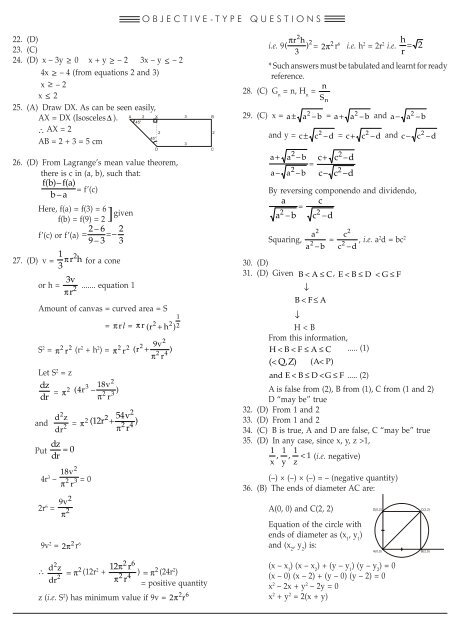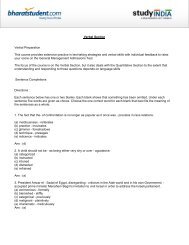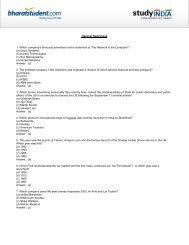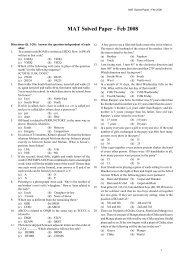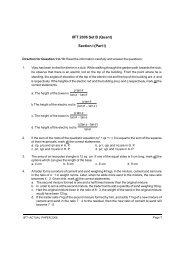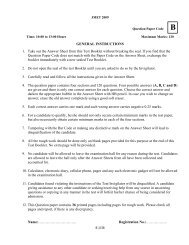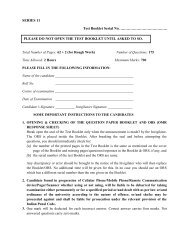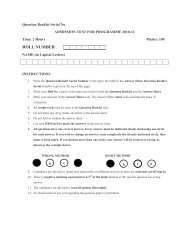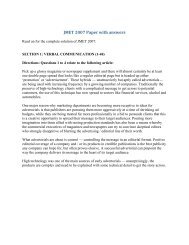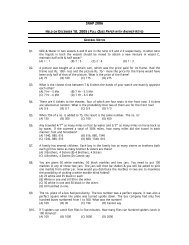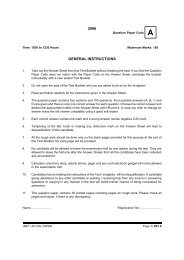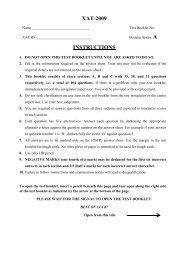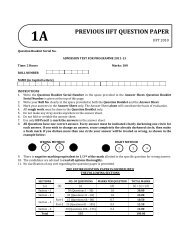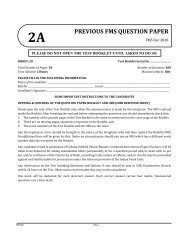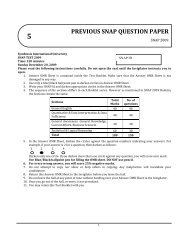QUANTITATIVE APTITUDE
QUANTITATIVE APTITUDE
QUANTITATIVE APTITUDE
Create successful ePaper yourself
Turn your PDF publications into a flip-book with our unique Google optimized e-Paper software.
22. (D)<br />
23. (C)<br />
24. (D) x – 3y ≥ 0 x + y ≥ – 2 3x – y ≤ – 2<br />
4x ≥ – 4 (from equations 2 and 3)<br />
x ≥ – 2<br />
x ≤ 2<br />
25. (A) Draw DX. As can be seen easily,<br />
2<br />
AX = DX (Isosceles∆ ). 45°<br />
∴ AX = 2<br />
45°<br />
AB = 2 + 3 = 5 cm<br />
26. (D) From Lagrange’s mean value theorem,<br />
there is c in (a, b), such that:<br />
fb ( )– fa ( )<br />
= f’(c)<br />
b– a<br />
Here, f(a) = f(3) = 6<br />
f(b) = f(9) = 2<br />
f’(c) or f’(a) = −<br />
− =<br />
2 6 2<br />
–<br />
9 3 3<br />
27. (D) v = 1 2<br />
πr h for a cone<br />
3<br />
or h = 3 ]<br />
v<br />
2 ....... equation 1<br />
πr<br />
given<br />
Amount of canvas = curved area = S<br />
OBJECTIVE-TYPE QUESTIONS<br />
= π rl = π r 2 2<br />
( r + h )<br />
S2 = 2 2<br />
π r (r2 + h2 ) = 2 2 2 9v<br />
π r ( r + )<br />
2 4<br />
π r<br />
Let S2 = z<br />
dz<br />
= π2 ( – )<br />
dr 4<br />
2<br />
3 18v<br />
r<br />
2 3<br />
π r<br />
and dz<br />
2<br />
2<br />
2 54v<br />
12r<br />
+<br />
2 4<br />
dr<br />
π r<br />
Put dz<br />
= 0<br />
dr<br />
4r3 2<br />
18v – 2 3 = 0<br />
π r<br />
2r6 9v 2<br />
= 2<br />
π<br />
9v 2 = 2 2<br />
π r 6<br />
∴ dz<br />
dr<br />
2 = π2 ( )<br />
A X 3<br />
B<br />
2<br />
=π<br />
2 2 (12r2 2 6<br />
12π r<br />
+ )<br />
2 4 =π<br />
π r<br />
2 (24r2 )<br />
= positive quantity<br />
z (i.e. S2 2 6<br />
) has minimum value if 9v = 2π r<br />
D<br />
2 2<br />
2<br />
1<br />
2<br />
3<br />
C<br />
πr h<br />
i.e. 9( )<br />
2<br />
2<br />
= 2<br />
3<br />
2<br />
π r6 i.e. h2 = 2r2 i.e. h<br />
= 2<br />
r<br />
* Such answers must be tabulated and learnt for ready<br />
reference.<br />
28. (C) G = n, H = n n n<br />
Sn 29. (C) x = 2<br />
a± a – b = 2<br />
a+ a – b and 2<br />
a−a – b<br />
and y = 2<br />
c± c – d = 2<br />
c+ c – d and 2<br />
c−c – d<br />
2<br />
a+ a −b<br />
=<br />
a– a<br />
2<br />
– b<br />
c c d +<br />
2<br />
−<br />
2<br />
c– c – d<br />
By reversing componendo and dividendo,<br />
a c<br />
=<br />
2 2<br />
a − b c −d<br />
Squaring, a<br />
a b<br />
2<br />
2 =<br />
– c<br />
2<br />
2 , i.e. a<br />
c – d<br />
2d = bc2 30. (D)<br />
31. (D) Given B< A≤ C,<br />
E< B≤ D < G≤F B<br />
B< F≤A B<br />
H < B<br />
From this information,<br />
H< B< F ≤ A≤ C ..... (1)<br />
( < QZ , ) ( A< P)<br />
and E < B ≤ D < G ≤ F ..... (2)<br />
A is false from (2), B from (1), C from (1 and 2)<br />
D “may be” true<br />
32. (D) From 1 and 2<br />
33. (D) From 1 and 2<br />
34. (C) B is true, A and D are false, C “may be” true<br />
35. (D) In any case, since x, y, z >1,<br />
1 1 1<br />
, , < 1 (i.e. negative)<br />
x y z<br />
(–) × (–) × (–) = – (negative quantity)<br />
36. (B) The ends of diameter AC are:<br />
A(0, 0) and C(2, 2)<br />
Equation of the circle with<br />
ends of diameter as (x , y ) 1 1<br />
and (x , y ) is:<br />
2 2<br />
(x – x 1 ) (x – x 2 ) + (y – y 1 ) (y – y 2 ) = 0<br />
(x – 0) (x – 2) + (y – 0) (y – 2) = 0<br />
x 2 – 2x + y 2 – 2y = 0<br />
x 2 + y 2 = 2(x + y)<br />
D(0,2) C(2,2)<br />
A(0,0) B(2,0)


